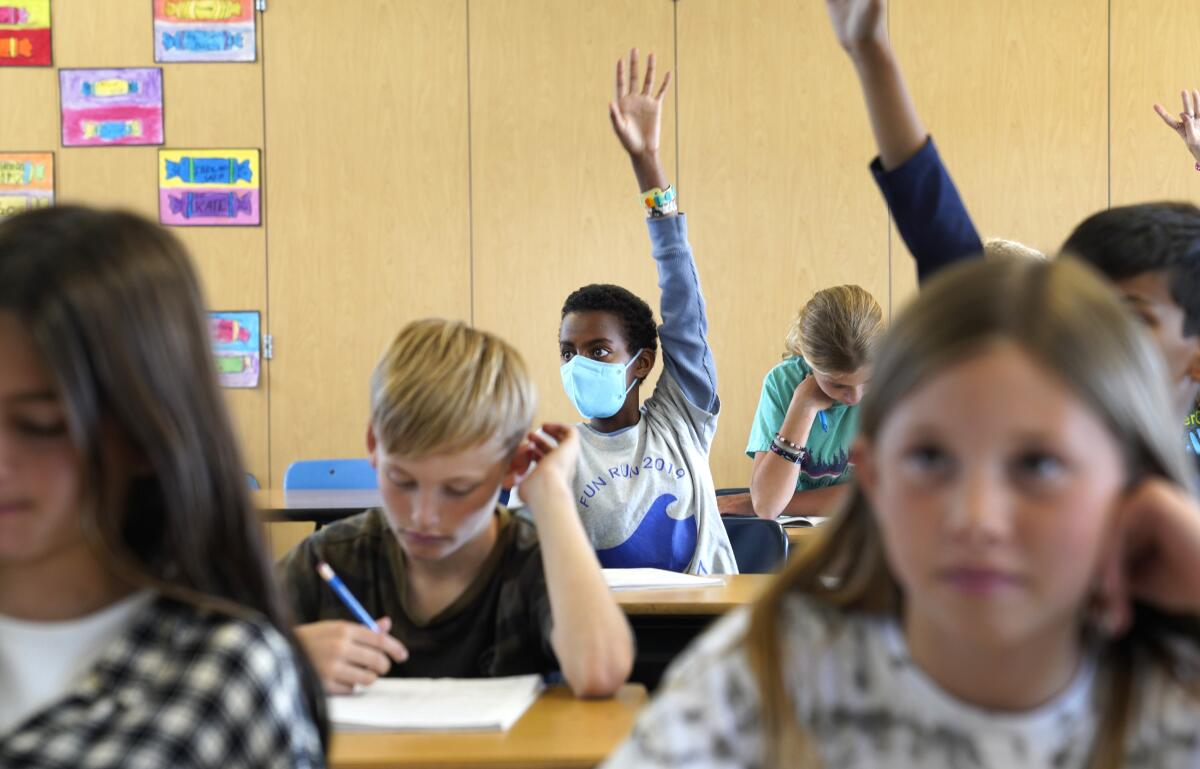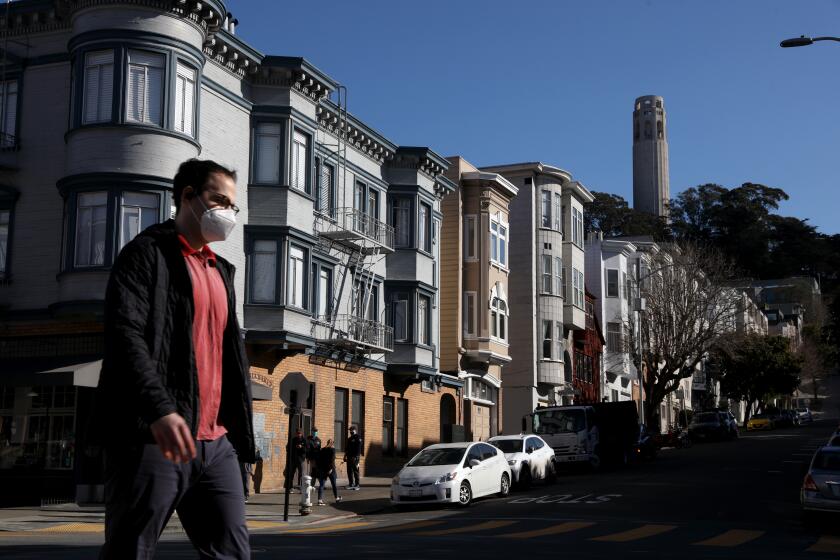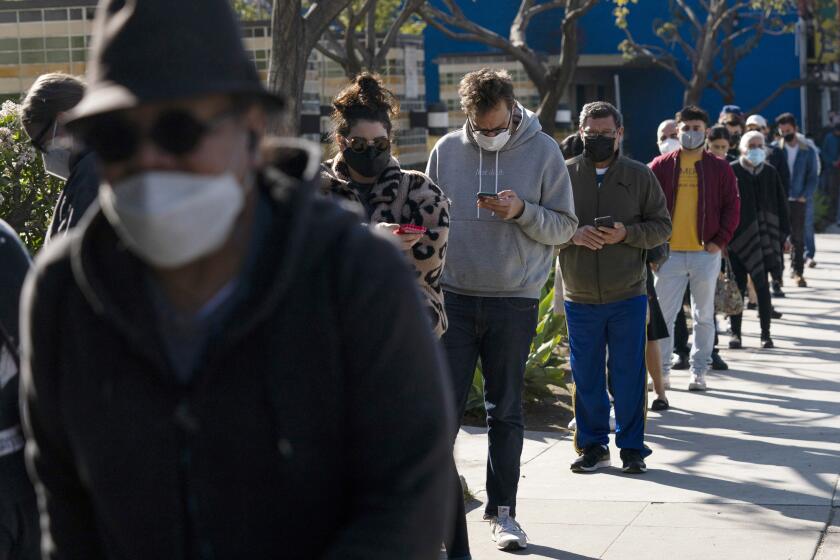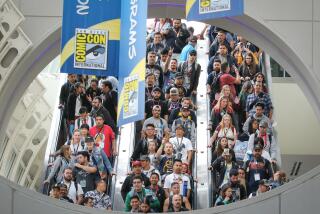California’s new coronavirus wave is disrupting lives, even with less severe illness

- Share via
A new surge of coronavirus cases is taking shape, as California slogs into a third pandemic summer with far fewer hospitalizations and deaths but still significant disruptions.
There are fewer cases of serious illness than occurred during other waves, underscoring the protection imparted by vaccinations, therapeutic drugs and, for some, partial natural immunity stemming from a previous infection.
Still, officials are deciding how best to respond now that cases are rapidly rising after plunging in the spring.
The extent of infection has prompted some schools, including UCLA, Cal Poly San Luis Obispo and Berkeley’s K-12 public schools, to reinstitute indoor mask mandates and has reignited concerns that hospitals may soon be asked to care for larger numbers of coronavirus-positive patients.
“If we continue on the current trajectory, we could find that cases and hospitalizations end up exerting stress on our healthcare system within just a few weeks,” Los Angeles County Public Health Director Barbara Ferrer said during a recent briefing.
Some observers say there’s no sign that California is nearing a peak, as the latest variant’s exceptional contagiousness is thought to be approaching that of measles. State modeling suggests that the spread of COVID-19 is likely still increasing in Southern California, the San Joaquin Valley and Greater Sacramento.
Even if hospitals don’t become burdened, there’s concern that climbing rates of transmission could keep people at home for a week or more, ruining plans for graduations, weddings and vacations and making it difficult for businesses to maintain adequate staffing.
There’s also worry that unlike in previous waves, people tired of the pandemic will be less willing to wear masks or take other measures to reduce coronavirus spread, potentially threatening the health of vulnerable people at higher risk of severe complications and increasing the chance of people suffering from long COVID.
Another bummer coronavirus summer for California? With cases on the rise, the state finds itself in a familiar, if frustrating, position.
In the San Francisco Bay Area, some businesses and institutions are taking care to avoid greater spread, including the Golden State Warriors, whose coach, Steve Kerr, was briefly out with a coronavirus infection as the team marched through the NBA playoffs, and Apple, which reportedly postponed a three-day-a-week return-to-work plan.
Statewide, officials are reporting nearly 15,000 new coronavirus cases a day, a rate nearly as high as during last summer’s Delta surge. The latest wave was spawned by the highly infectious Omicron strains.
San Francisco has one of the state’s highest coronavirus case rates, reporting nearly 400 a week for every 100,000 residents as of Monday. Los Angeles County was reporting 310 cases a week for every 100,000 residents as of Wednesday. A rate of 100 or more is considered high.
“It’s now a big-time surge,” Dr. Robert Wachter, chair of UC San Francisco’s Department of Medicine, tweeted Monday. “No longer just cases … also major uptick in hospitalizations. … If you’re trying to stay well, time to up your game.”
Masks may not be required in many places but they’re still encouraged, officials say, as new COVID cases continue to climb.
While the daily census of coronavirus-positive patients in hospitals has risen lately, it has done so at a much slower pace than in previous surges. On the whole, the patient count remains far lower than in the past.
Statewide, 2,281 coronavirus-positive patients were hospitalized as of Tuesday — up 41% from two weeks ago. By comparison, daily hospitalizations surpassed 8,300 during the height of the Delta wave and topped 15,400 at the peak of the first Omicron surge.
Additionally, some hospital officials in recent weeks have noted that most of the coronavirus-positive patients are not being treated for COVID-19; they may have been admitted for other reasons and tested positive while in the hospital.
“We are not seeing COVID pneumonia. We’re seeing flu-like illnesses,” tweeted Dr. Brad Spellburg, chief medical officer of L.A. County-USC Medical Center, noting that patients are going home after being seen in the emergency room.
Of about 10 coronavirus-positive patients at his public hospital, only one was admitted primarily for COVID-19, Spellburg said.
However, Ferrer noted that coronavirus-positive patients take up hospital resources, in part to keep them isolated.
“The more cases you have — even if it’s just a small fraction of people who get infected and need to be hospitalized — the greater the strain will be on the healthcare system,” she said.
Los Angeles, Orange, Riverside and San Bernardino counties have all seen upticks in coronavirus case rates.
In L.A. County, there were 502 coronavirus-positive patients in public and private hospitals as of Tuesday. That’s up 38% from two weeks before. In San Francisco, there were 96 patients, up 26% over the same period.
“The rate of increase in hospital admissions are of concern,” said Ferrer, who characterized the increase in L.A. County as occurring at a “modest pace.”
Computer models posted to the state’s COVID-19 forecasting website indicate increasing hospitalizations in the weeks to come — with coronavirus-positive intensive-care patients projected to almost quadruple from 242 to close to 950 by the beginning of July. That’s not as high as the winter Omicron peak of about 2,600 but would represent a significant increase from the post-winter low of 112.
State modeling also projects that the overall daily number of hospitalized coronavirus-positive patients could approach 5,000 by the end of June.
Nationwide, COVID-19 deaths started to increase in the days leading up to Memorial Day weekend. The U.S. was reporting an average of 317 COVID-19 deaths a day for the seven day period that ended Friday, up 10% from the previous week. The U.S. Centers for Disease Control and Prevention is now forecasting that daily COVID-19 deaths will likely increase through at least late June, possibly reaching more than 770 a day.
California is averaging 33 COVID-19 deaths a day, a level that has remained stable.
Coronavirus infections have increased 63% statewide, bringing the case rate to 231 for every 100,000 California residents. Hospitalization rates are rising but remain low.
Some medical experts have recently pushed back against what they consider an overly optimistic sentiment that increases in coronavirus cases don’t really matter, because immunization rates have lowered the risk of hospitalization and death.
“There is no way to get around the reality that surges of COVID-19 are problematic — they result in people being sick enough to be out of work; others sick enough to be in the hospital; others sick enough to have longer term issues,” tweeted Dr. Abraar Karan, an infectious-disease expert at Stanford University. “Normalizing surges is bad public health.”
A coronavirus infection brings with it the risk of developing long COVID, in which symptoms like fatigue, difficulty breathing and brain fog can persist for years.
A report published last week in the journal Nature Medicine analyzed health records of veterans and found that vaccinated people who were infected with the coronavirus have some risk of experiencing long COVID. The study reviewed records prior to Dec. 1, before the Omicron wave accelerated in the U.S.
“The findings suggest that vaccination before infection confers only partial protection in the post-acute phase of the disease,” the study said. Reliance on vaccines alone and not using other strategies to reduce risk “may not optimally reduce long-term health consequences” from a coronavirus infection, the report said.
A separate report, published last week by the CDC, said roughly 1 in 5 adults who survived COVID-19 have a health condition that might be related to their infection, such as problems affecting the heart or lungs.
It’s “wishful thinking” to imagine that recurrent COVID-19 illnesses “aren’t a big deal,” Wachter tweeted. The truth, he said, is that risks of getting long COVID from “recurrent cases of COVID aren’t yet clear.”
More to Read
Sign up for Essential California
The most important California stories and recommendations in your inbox every morning.
You may occasionally receive promotional content from the Los Angeles Times.
















